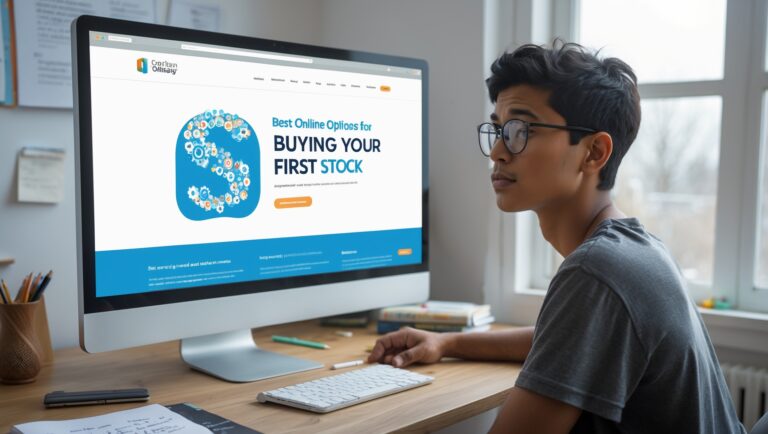How to Make Your First $1,000 Investing in Stocks
How to Make Your First $1,000 Investing in Stocks
Wondering how to grow your portfolio? Learn how to make your first $1,000 investing in stocks with beginner-friendly strategies, tips, and tools I personally use.

Table of Contents
When I first started investing, my goal wasn’t to get rich overnight—it was just to make my first $1,000 in the stock market. That milestone felt like proof that I could actually grow my money through investing. And when I finally hit it, I realized it wasn’t about luck—it was about having a clear plan, sticking to simple strategies, and being patient.
If you’re just starting out, I want to show you how I built that first $1,000 and how you can too.
Step 1: Start Small but Be Consistent
The first thing I learned is that you don’t need a huge amount of money to begin. I started with small contributions, sometimes as little as $50 or $100 at a time. What mattered most was consistency.
By adding money regularly, even in small amounts, my portfolio slowly grew. Consistency is what turns small beginnings into big results.
Step 2: Use the Right Broker
Your choice of broker makes a difference. I personally started with Robinhood because of its simplicity and fractional shares. Later, I also used Webull for its research features and the free stock rewards they offer.
For tracking progress and analyzing charts, TradingView became my favorite tool. It helped me see my growth and gave me confidence to stay on track.
Step 3: Focus on Quality Companies
At first, I made the mistake of chasing hype stocks. It rarely worked. What helped me reach my first $1,000 was focusing on companies with strong track records, solid growth, and products I actually used.
Investing in quality companies kept my money safe and growing steadily.
Step 4: Take Advantage of Dividends
Dividends were my secret weapon. Some of the stocks I bought paid me just for holding them. Instead of cashing out those dividends, I reinvested them. Over time, this compounding helped my portfolio cross that $1,000 mark faster.
Even small dividend payments add up when reinvested.
Step 5: Use Dollar-Cost Averaging
Trying to time the market stressed me out and usually backfired. What worked better was dollar-cost averaging—investing a fixed amount regularly. Some months I bought at higher prices, some months lower, but over time, it evened out.
This strategy protected me from big mistakes and kept my money growing.
Step 6: Avoid Common Mistakes
The biggest mistakes that slowed me down early on were selling too quickly, chasing hype, and investing money I couldn’t afford to lose. Once I stopped doing those things, my portfolio grew faster and more steadily.
Patience and discipline matter more than quick wins.
Step 7: Track and Celebrate Progress
I remember the first time my account crossed $500, then $750, and finally $1,000. Tracking progress made the journey exciting. Even small wins were worth celebrating because they reminded me that my money was working for me.
Using platforms like TradingView made it easy to see that growth in real time.
Final Thoughts
Making your first $1,000 in stocks isn’t about luck—it’s about starting small, being consistent, and sticking to smart strategies. Once you hit that milestone, you’ll realize how much potential the stock market truly has for building long-term wealth.
If you want a step-by-step roadmap for how I personally used stocks to pay bills and grow wealth, check out my ebook here.
And if you’re ready to get started today, here are the platforms I personally recommend:
- Robinhood – simple and beginner-friendly
- Webull – great research features and free stocks on signup
- TradingView – track your progress and analyze stocks
Start today, stay consistent, and watch your portfolio grow to that first $1,000—and beyond.
When I finally crossed the $1,000 mark, I realized it wasn’t one big trade that got me there—it was the small, steady actions I took consistently. That’s the part most beginners miss. They look for a single stock to make them rich overnight, but wealth comes from patience and discipline.
One of the things that really helped me was setting a timeline. I told myself I wanted to reach $1,000 in a year, not a month. That mindset gave me permission to grow steadily instead of taking reckless risks.
I also made a habit of reinvesting every dollar I earned. Dividends, small gains, even free stock rewards from brokers like Webull—I put it all back into my portfolio. That compounding effect sped up my journey to $1,000.
Tracking progress became one of my biggest motivators. I loved seeing my account move from $200 to $400 to $700. Every milestone reminded me that I was closer to the goal. That’s why I recommend using tools like TradingView to visualize your growth—it makes the journey exciting.
I also realized that cutting losses quickly was just as important as letting winners run. At first, I held onto bad stocks hoping they’d bounce back. But that slowed me down. Now, I cut weak positions early and reinvest into stronger companies.
One beginner mistake I avoided later was overtrading. I thought being active meant being successful, but I learned that trading too often eats away at your gains. Buying and holding quality companies got me to $1,000 much faster.
Consistency was my biggest edge. Even if I only had $20 one week, I invested it. Those little deposits built momentum and turned into real progress. Starting small doesn’t mean staying small.
I also focused on companies that matched my personal values. Investing in businesses I believed in kept me motivated and confident during dips. When you believe in the company, you’re less likely to panic sell.
Another thing that helped was staying away from hype. Every time I chased a stock because it was “going viral,” I lost money. When I stuck to research and trusted my plan, my portfolio grew.
Setting realistic expectations kept me grounded. Instead of dreaming about $10,000 overnight, I celebrated that first $100, then $500, then $1,000. Each small win stacked up until I hit my goal.
I learned to use volatility to my advantage. When the market dipped, I didn’t panic—I bought more of the companies I already believed in. Those discounted buys pushed me closer to my $1,000 faster than I expected.
Having a clear exit plan also helped. For some stocks, I decided in advance whether I was holding long term or selling once I reached a profit target. That discipline stopped me from making emotional decisions.
I treated my first $1,000 as proof, not the finish line. Once I saw that I could grow money steadily, I felt confident enough to set bigger goals. That milestone was just the beginning.
One of the smartest moves I made was diversifying my approach. I combined dividend-paying stocks for income with growth stocks for appreciation. That balance helped me reach $1,000 without too much risk.
Finally, I reminded myself constantly that investing is a journey. It’s not about rushing to $1,000—it’s about building habits that will take you to $10,000, $50,000, and beyond. That first milestone is just the foundation of everything else.

Stay ahead in the stock market! Subscribe to our newsletter and receive exclusive stock flow reports, trading insights, and actionable tips directly in your inbox. Join thousands of traders who get our updates first.







